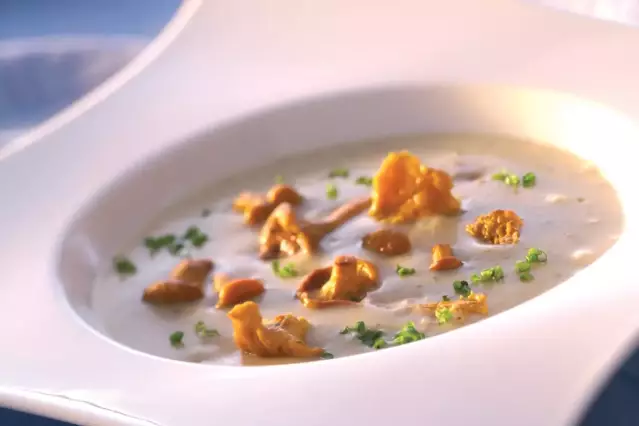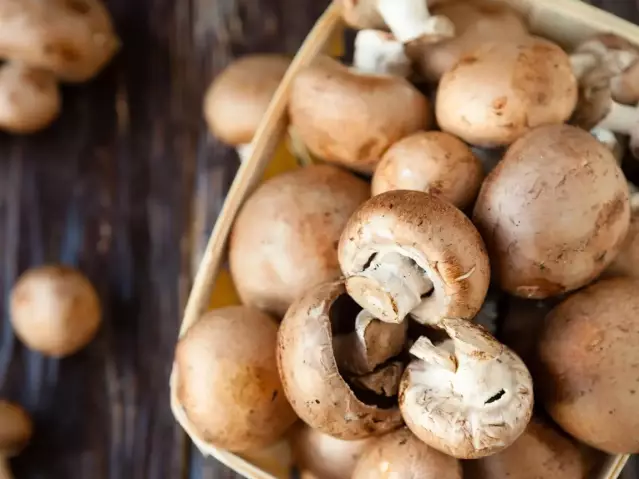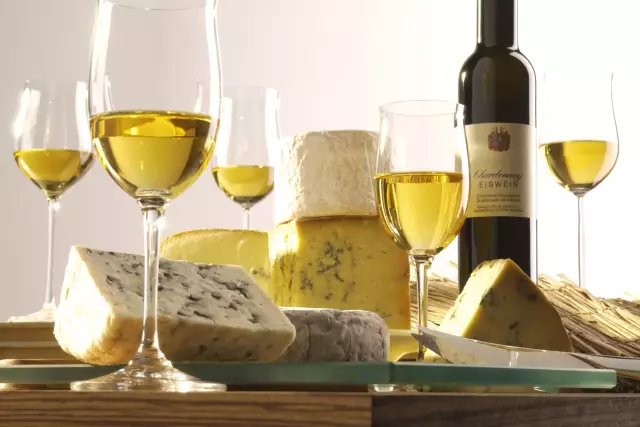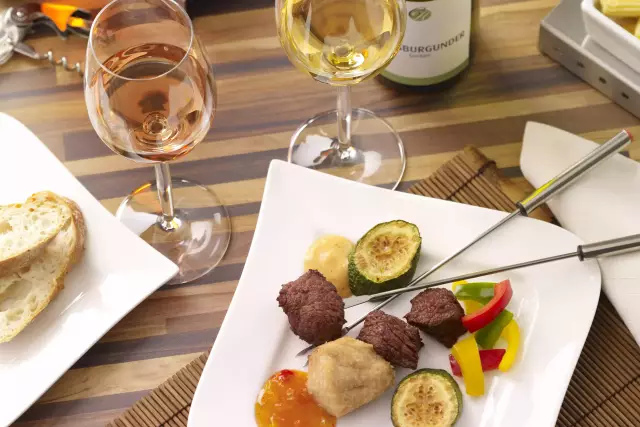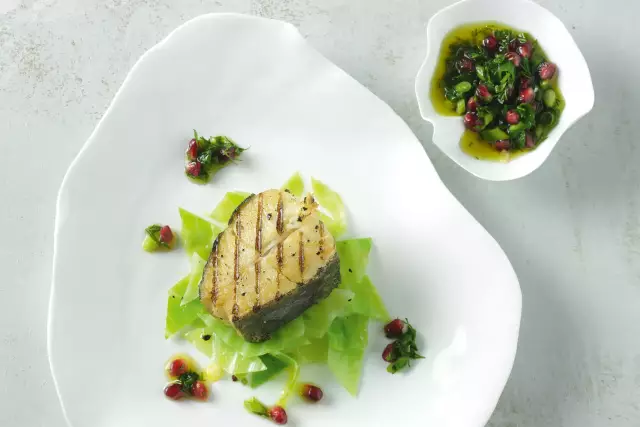Mushrooms & Wine
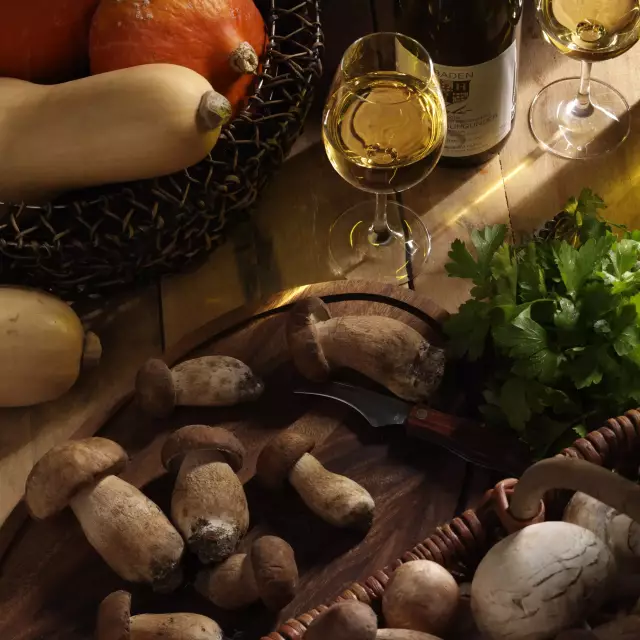
Wild mushrooms can be quite demanding in their choice of culinary partners and prefer wines with subtle and mild flavours. While a delicate potpourri of mixed mushrooms requires a full-bodied wine, flavours should not be too overwhelming.
Facts
-
2019
The chanterelle was the mushroom of the year
-
The fourth
Saturday in September is celebrated annually as European Mushroom Day.
-
About 2kg
mushrooms are consumed per capita in Germany every year
Delicious pairings - Wild mushrooms and wine
Take porcini, for instance: These most exquisite of all edible mushrooms form a perfect symbiotic relationship with a Pinot Blanc that is full-bodied yet delicately fruity. Even rather mature wines are great companions, since the subtle flavours of the mushrooms make them appear youthful and fresh. A mild acidity retains the harmony of this delicate, melt-in-the-mouth dish.
More expressive dishes, such as porcini or other mushrooms that have been fried to crispy perfection in butter, harmonize well with heartier wines with a fresh, fruity acidity, such as Riesling – a delectable alliance.
Wild mushrooms play a pleasant supporting role alongside a roast. In this case, the roast takes precedence in selecting the wine companion. However, wines such as a smooth Pinot Noir from the Ahr region or a subtle Meunier (Schwarzriesling) from Württemberg take care that the delicate mushroom flavours don’t get lost in this expressive mélange.
Mushrooms as a main dish, with a rich creamy sauce and dumplings, require a subtly fruity fresh Riesling that counters the exquisite opulence of the dish with its vivacity.
Autumn creations - wine harmony guaranteed
Whether you require a companion for delicately flavoured wild mushrooms or pumpkins: In the cellars of the German winemakers, a parade of fantastic wines is ready to give a brilliant performance on your table. And Wines of Germany has a few simple guidelines for you to follow – to avoid even the slightest hints of disharmony creeping into these alliances.
Wild mushrooms such as porcini, bay boletes and chanterelles
Braised, wild mushrooms tend to display extremely delicate flavours and acquire a melt-in-the-mouth touch. Most often, they are lightly sautéed in a frying pan with onions, only seasoned slightly and rounded off with a dash of lemon, in order to preserve their subtle nutty taste. Suitable wine companions should also help to retain the delicate mushroom flavours. A gentle Pinot Blanc or a Silvaner from Rheinhessen does a great job.
Crisp-fried in butter, porcini develop very distinct nuances. Their typical flavours form a delicious alliance with the delicate roast aromas. A smooth Riesling with a moderate fruity acidity is a welcome companion. It showcases the spicy nuances of the mushrooms. As far as red wines are concerned, a more distinctly fruity Pinot Noir or Portugieser fits the bill.
In a creamy sauce, mushroom dishes are not exactly light fare. A full-bodied Riesling or classic Pinot Gris makes for a happy combination. The wine’s balanced acidity, subtle richness and maybe even a hint of residual sugar are excellent counterparts for the potpourri of flavours created by braised mushrooms, cream and fresh herbs.
Mushrooms play an expressive supporting role alongside a roast. In this kind of menu, the roast takes precedence in selecting the wine companion. However, it’s a good idea to also pay attention to a harmonious relationship between wine and mushrooms. Smooth red wines with balanced tannins such as Pinot Noir from Baden or the Ahr region are commendable. Hearty red wines rich in tannins would take center stage here – and drown out the delicate mushroom aromas.
Can wines themselves develop a mushroom or champignon aroma?
Yes! This aroma manifests itself in earthy, spicy tones such as forest floor or foliage, but in extreme form it can also develop into an off-flavor. This strong mushroom note is caused, among other things, by the substance geosmin, which in turn can be caused by botrytis infestation.
Varietals

with chanterelle and onion leek, served with potato and grilled cheese ragout in grilled tomato Chop of Hunsrück veal
with chanterelle and onion leek, served with potato and grilled cheese ragout in grilled tomato
- 4 x 300 Gramm Kotelettes
- 250 Gramm Pfifferlinge
- 4 große Kartoffeln
- 2 große Grilltomaten
- 180 Gramm Flammkäse
- 50 Gramm Knollensellerie
- 200 ml Spätburgunder
- 200 ml Sahne
- 50 Gramm Butterschmalz
- 2 EL Butter
- 1 EL Rapsöl
- 6 Stück Lauchzwiebeln
- 1 kleine Knoblauchzehe
- je 1 Zweig Thymian & Rosmarin
- je 1 TL Majoran & Oregano
- nach Belieben Salz & Pfeffer
Peel the potatoes, celery and garlic clove, crush the garlic and cut the potatoes and celery into small cubes. Heat the rapeseed oil in a pan, add the potato and celery cubes, sauté briefly and top up with ⅔ of the cream. Season with salt, pepper and the crushed garlic and leave to simmer for approx. 6 minutes. Add the oregano, marjoram,
add a little thyme and the diced flambé cheese and remove from the oven immediately.
Season the veal chops with pepper, fry in the pan in hot clarified butter for approx. 3 to 4 minutes on both sides and then cook in the oven at 160 degrees for 8 to 9 minutes. Then leave the meat to rest briefly.
Cut the grilled tomatoes in half, remove the skin, place on a baking tray and fill with the potato and flambé ragout. Place the baking tray in the oven with the chops for approx. 6 - 7 minutes. Add 1 tbsp of butter and the sprig of rosemary to the roasting mixture, deglaze with the Pinot Noir, reduce a little and refine with the remaining cream. Season to taste with salt and pepper.
Clean the chanterelles and spring onions. Wash the spring onions well, cut into 5 cm pieces, blanch briefly in salted water and rinse in ice water. Heat 1 tbsp butter in a pan, add the chanterelles and sauté for 2 - 3 minutes. Add the spring onions and the rest of the thyme and season with salt and pepper.
<p- Riesling (trocken)
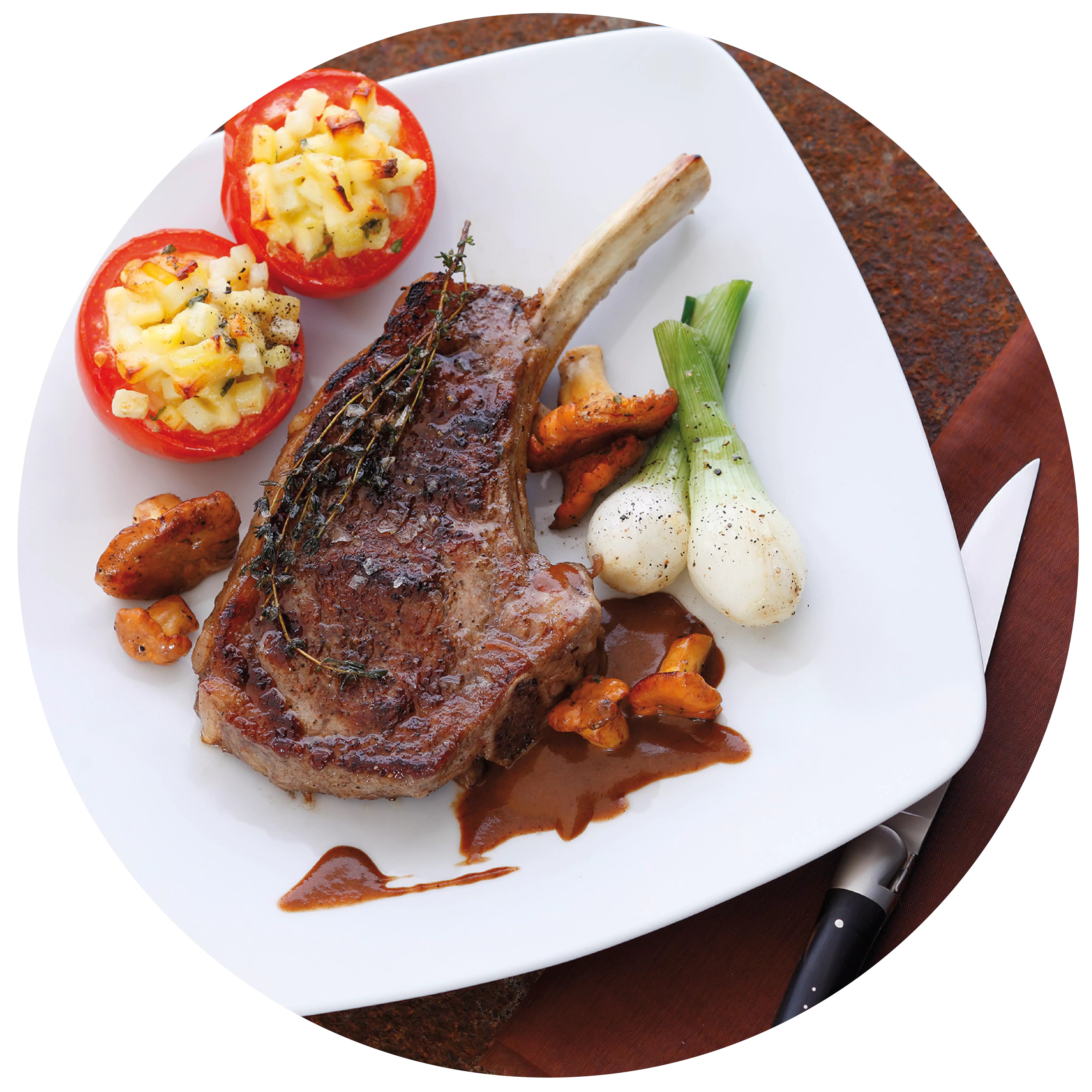
with fresh chanterelles Autumn bruschetta
with fresh chanterelles
- 4 Ciabatta-Brötchen
- 200 Gramm kleine Pfifferlinge
- 4 EL kleingehackte Petersilie
- 4 Zehen Knoblauch
- 80 Gramm Pecorino (Hartkäse)
- 8 EL kaltgepresstes Olivenöl
- Eine Prise Salz & Pfeffer
Preheat the oven to 200 degrees.
Clean the chanterelles. Sauté the parsley in a pan with half of the oil, then add the mushrooms and cook over a low heat for approx. 5 minutes.
Slice the rolls and bake for approx. 5 minutes until crispy.
Chop the garlic into small pieces, spread on the warm bread rolls and drizzle with the other half of the oil. Coarsely grate the pecorino.
Stir the chanterelle and parsley mixture into the pecorino and spread over the halves of the rolls.
- Pinot Gris (trocken)
- Federweißer (brut nature)

with goat's cheese Courgette and chanterelle salad
with goat's cheese
- 2 ganze Zucchini
- 3 EL Rapsöl
- 1 kleine Schalotte
- 300 Gramm Pfifferlinge
- 1 Msp. gemahlener Piment
- 2 Bund Rucola
- je 1/2 Bund Kerbel u. glatte Petersilie
- je 3 EL Walnuss- u. Rapsöl
- 4 Stück Ziegenkäse-Taler
- 1 Prise Zucker
- nach Belieben Salz & Pfeffer
Salad:
Wash the courgettes and slice thinly. Place in a bowl and mix with the oil.
Heat a grill pan and fry the courgettes in batches until golden brown. Season with salt and pepper, place in a bowl.
<p
<p>Peel and finely dice the shallot. Clean the chanterelles, wash if necessary and pat dry. Depending on size, cut in half if necessary.
<p
<p>Sauté the shallot in a pan until translucent. Add the chanterelles and fry vigorously for 3 minutes while stirring. Season with salt, pepper and allspice. Add to the courgettes. Wash the rocket and spin dry.
Dressing:
Wash the herbs, shake dry. Pluck the leaves, blend finely with both types of oil and vinegar in a blender or with a hand blender. Flavour with salt, pepper and sugar. Pour over the courgette and chanterelle mix and mix loosely with the rocket. Arrange on plates, sprinkle with goat's cheese.
- Pinot Blanc (trocken)
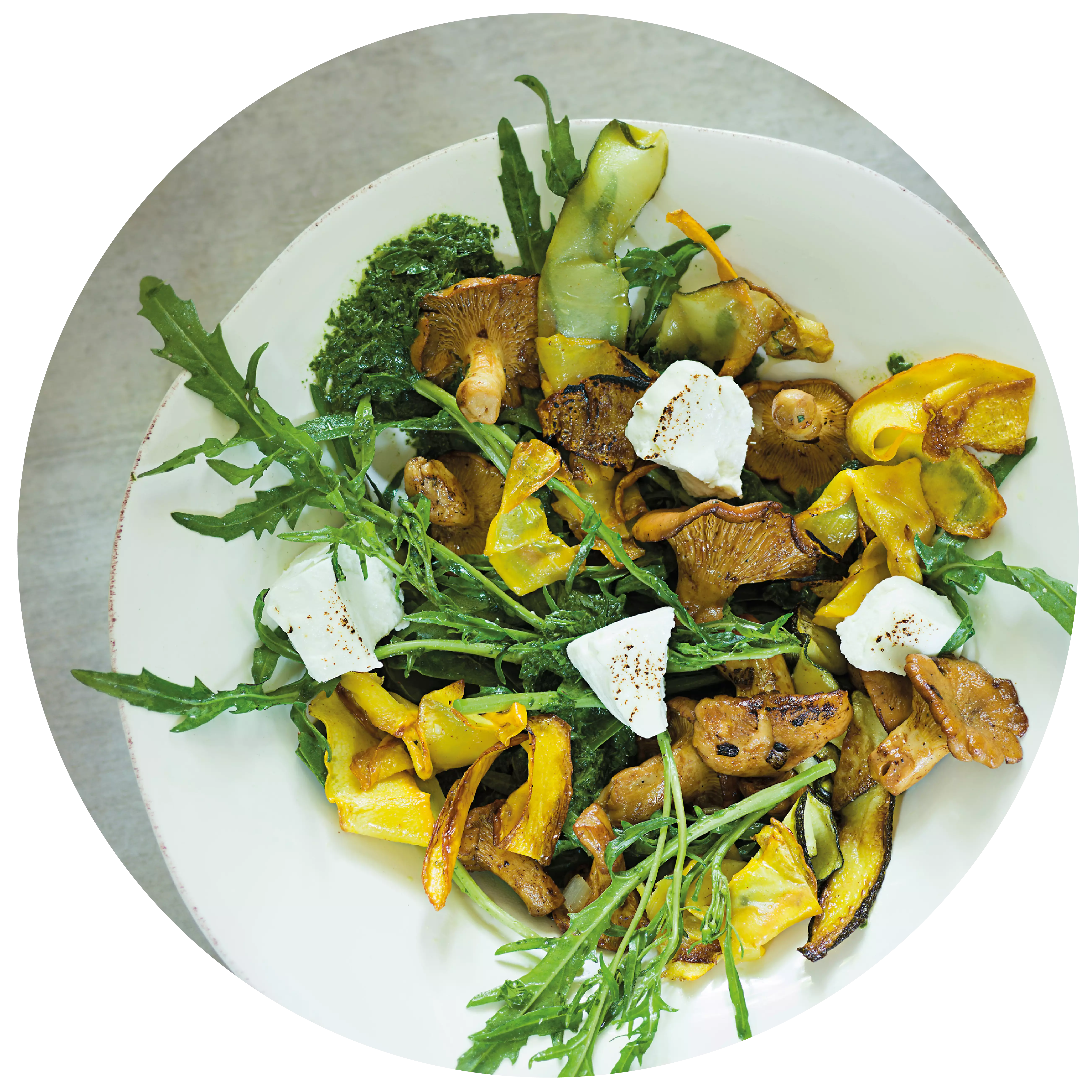
with wild mushrooms Cream of potato soup
with wild mushrooms
- 300 Gramm geschälte Kartoffeln
- 100 Gramm Wurzelgemüse
- 100 Gramm Waldpilze
- 1 ganze Zwiebel
- 1 ganze Knoblauchzehe
- 30 Gramm Speckwürfel
- 40 Gramm Margarine
- 750 ml Brühe
- 200 ml Sahne
- 1 Zweig Thymian
- nach Belieben Petersilie, Butter, Salz, Pfeffer, Muskat
Clean, wash and finely dice the root vegetables. Finely dice the onion and garlic clove and finely chop the thyme. Sauté the diced bacon with the margarine in a pan until lightly browned, add the diced onion, garlic, root vegetables and thyme. Sauté, add the stock and cook for 2 minutes.
Finely grate the potatoes, add to the soup and cook for a further 5 minutes, add the cream, season and flavour. Clean, wash and chop the mushrooms and sauté in a pan with butter. Season with salt and pepper, sprinkle with chopped parsley and pour over the soup when serving.
- Riesling (trocken)
- Riesling (halbtrocken & feinherb)
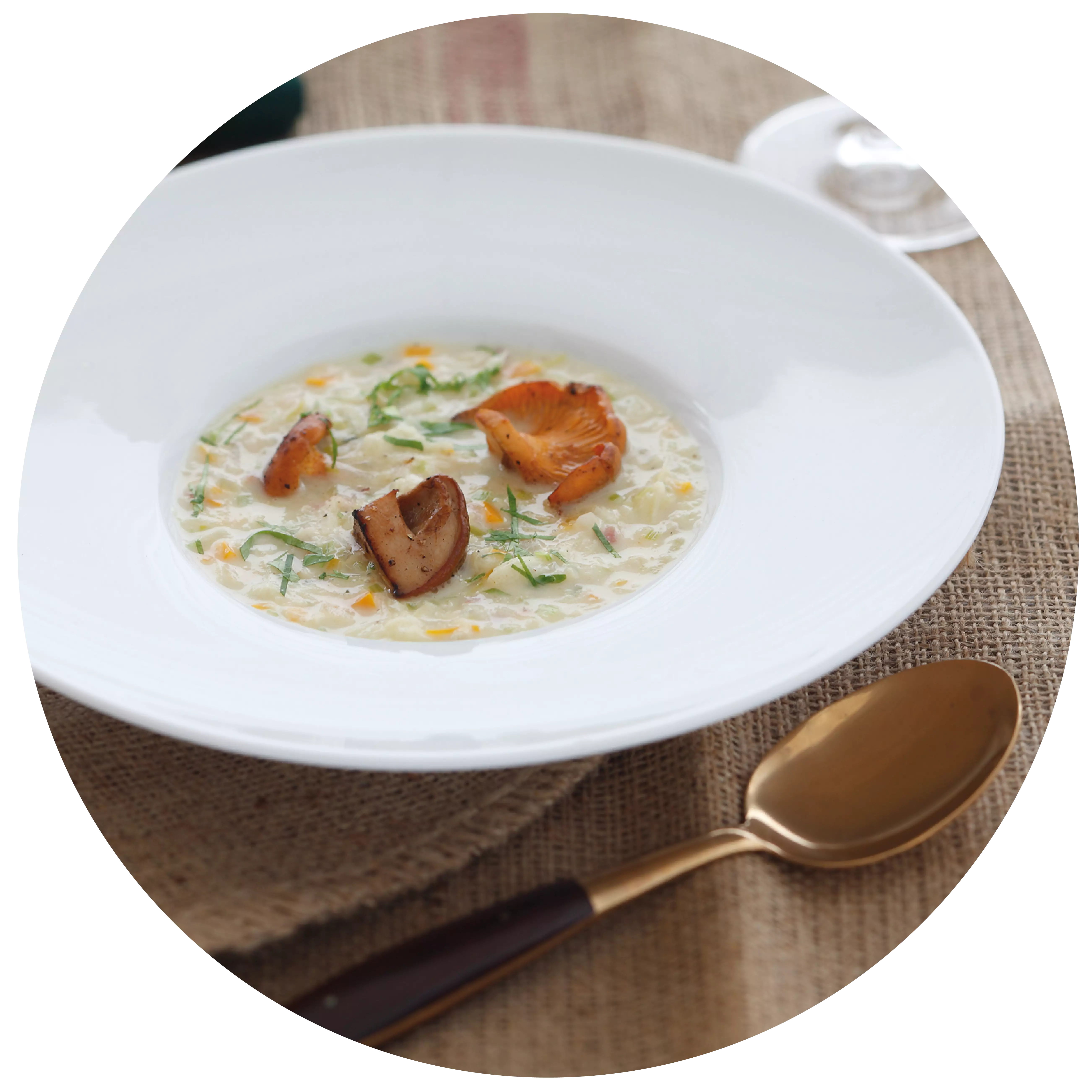
Teaser
Events
-
Show
winetasting in our winery - cheese & wine
Mainz-Hechtsheim


